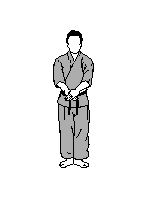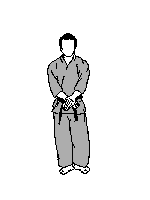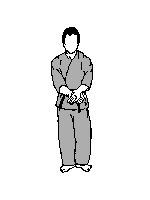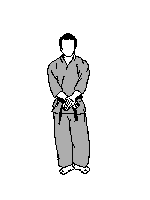
HEIAN (SHODAN)
"Peaceful Mind Beginning Step form" "Heavenly Peace"
A kata taken from the Japanese Shotokan style and modified for use in Karate Jutsu. It is the first of a series of 5 Heian kata practised in the Shotokan style. Shotokan is a Japanese style derived from the Okinawan Shorin-Ryu style by Gichin Funakoshi. The original Shorin-Ryu kata were the Pinan series kata, which were modified by Funakoshi to become the Heian series of kata, now practised by Shotokan.
GEKI SAI DAI ICHI
"Attack, crush, destroy, demolish #1"
This is an Okinawan Goju Ryu Kata developed by Chojun Miyagi in 1940 as a form of physical exercise for high school boys and to help popularize Goju-Ryu among the public of Okinawa. even though these Kata were designed primarily as a form of exercise, Miyagi Sensei included his understanding of combat as part of their makeup. Variations are also practiced within other styles.
GEKI SAI DAI NI
"Attack, crush, destroy, demolish #2"
This is an Okinawan Goju Ryu Kata developed by Chojun Miyagi. The Gekisai Kata are easier to learn and perform, and contain dynamic techniques which are more attractive to young people. Variations are also practiced within other styles.
SAIFA
"Crush, tear, shatter"
This is an Okinawan Goju Ryu Kata which Kanryo Higaonna adopted from the Chinese martial arts he studied. It is the first of the classic combative Kata taught in Goju-Ryu. Goju-Ryu's Kata origins come from the martial arts taught in the Fuzhou area of southern China, largely Crane and Xingyi/Baqua as well as other internal and external martial arts. Kanryo Higaonna Sensei was taught this Kata, along with the other Kata of Goju-Ryu, while he studied in China from 1863-1881 under the direction of RuRuKo (Xie Zhongxiang in Chinese) and others. Variations are also practiced within other styles.
NAIFUNCHIN
"Fight without boundary"
This is a Shorin Ryu Kata (Naihanchi Sho) part of a series of 3 kata. Also used as the first of a series of 3 kata in Shotokan under the name of Tekki Shodan. (Iron Horse)
SEIYUNCHIN
"Conquer over a distance" "To draw/suck/pull in and battle" "Marching/Conquer far quietly" "Control, suppress and pull" "To pull off balance and fight"
This is an Okinawan Goju Ryu Kata which Kanryo Higaonna adopted from the Chinese martial arts he studied. The name Seiyunchin implies the use of techniques to off balance, throw and grapple. Seiyunchin contains close-quartered striking, sweeps, take-downs and throws. Though the Kata itself is void of kicks, many practitioners make the grave mistake by missing the opportunity to apply any leg technique. Variations are also practiced within other styles.
SHISOCHIN
"Conquer 4 directions" "Four gated battle" "Four direction battle" "To defeat attacks from four sides"
This is an Okinawan Goju Ryu Kata which Kanryo Higaonna adopted from the Chinese martial arts he studied. The third kanji is the same found in Sanchin and Seiyunchin, which translates as "battle" or "conflict". This lends to a deeper definition of its meaning. The idea of four directions can come from the performance of the four shotei in four directions. It can also represent the four elements represented in Chinese medicine (Acupuncture is one) of Wood, Fire, Metal and Water with man representing Earth. Variations are also practiced within other styles.
SANSERU
"Thirty six hands"
This is an Okinawan Goju Ryu Kata which Kanryo Higaonna adopted from the Chinese martial arts he studied. A realistic explanation of this and the other numerically named Kata is that they refer to a systematic method and understanding of certain groupings of vital acupressure points. It is this science that the martial arts was based upon and developed. Variations are also practiced within other styles.

SEPAI
"Eighteen hands"
This is an Okinawan Goju Ryu Kata which Kanryo Higaonna adopted from the Chinese martial arts he studied. The most apparent and most meaningful in the naming of Sepai is again from the martial arts development and the use of attacking pressure points. 18 is one half of 36 suggesting that perhaps an alternative set of attacks and defenses of preferred techniques and strategies from the original Sanseru 36. Variations are also practiced within other styles.

SEISAN
"Thirteen hands"
This is an Okinawan Goju Ryu Kata which Kanryo Higaonna adopted from the Chinese martial arts he studied. Seisan is believed to be the oldest of all Okinawan Goju-Ryu Kata. There is a version of Seisan practiced in the Shorin schools, but in comparison, the Goju-Ryu version is longer and much more complex. Variations are also practiced within other styles.

KURURUNFA
"Forever peacefulness-stops-shatter" "To remain still, then quickly attack
and destroy" "Holding ground" "Armageddon" "Silence before the storm"
This is an Okinawan Goju Ryu Kata which Kanryo Higaonna adopted from the Chinese martial arts he studied. Kururunfa epitomizes the ideals of Go-"hard and Ju-"soft". Stance transitions are quick and explosive while the hands techniques are employed using "muchimi" or a heavy, sticky movement. As in the other kata of Goju-Ryu, it is quite evident that grappling and close-quartered fighting is the favored fighting style. Variations are also practiced within other styles.

SUPARINPEI
"One Hundred and Eight Hands"
This is an Okinawan Goju Ryu Kata which Kanryo Higaonna adopted from the Chinese martial arts he studied. Suparinpei is the most advanced Kata in Goju-Ryu. It contains the greatest number of techniques and variations. Suparinpei is deceptive in that it appears simple in execution but when combined with transitions and changing tempos, it is only surpassed by Sanchin in technical difficulty and understanding. Variations are also practiced within other styles.

SANCHIN
"Three Battles/Conflicts"
One of two "heishu " Kata of Goju-Ryu, Sanchin is probably the most misunderstood Kata in all of Karate. In contrast, it is probably the single most valuable training exercise in Goju-Ryu. Sanchin has such aspects as deep, diaphragmatic breathing found in many internal arts as well as external attributes like mechanical alignment and muscular strength. Sanchin translates as "3 Battles" or "3 Conflicts". This has many meanings. First it refers to the struggle to control the body under physical fatigue. With fatigue the mind begins to lose focus and thus the spirit begins to diminish as well. Therefore Sanchin develops discipline, determination, focus, perseverance and other mental attributes. The Chinese refer to this as Shen (spirit), Shin (mind) and Li (body).
